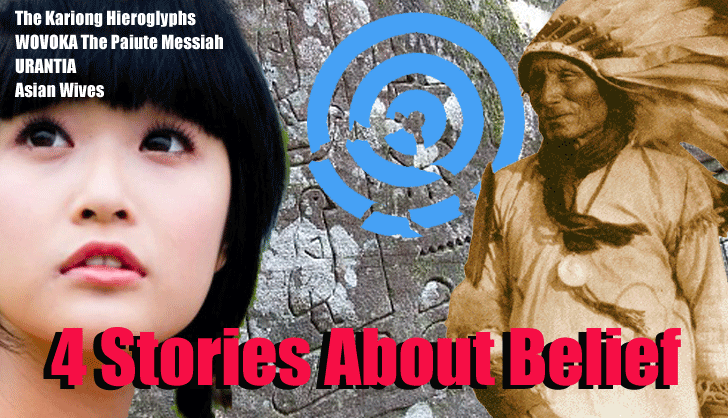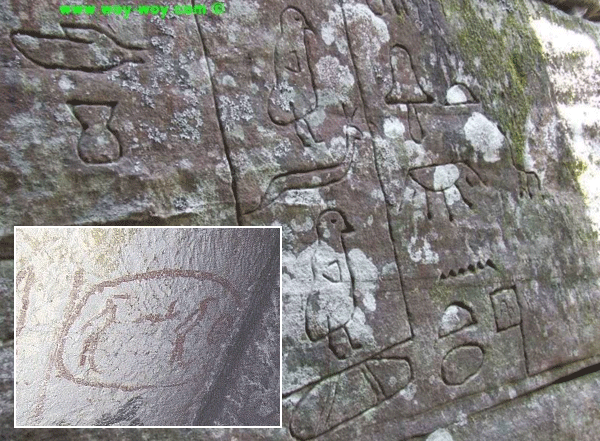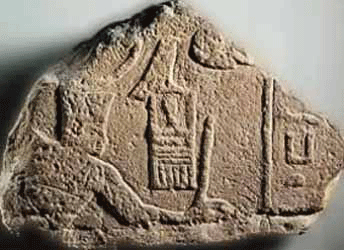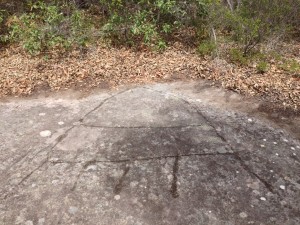

Initially, according to Steve Strong, the authorities were very interested in the Kariong Glyphs but after several prominent Egyptologists and historians ridiculed the idea of Egyptians being in Australia the interest cooled.

Photographs like the ones above seem to show that additions have been made to the site since its discovery. The ears of a large figure, described by some as Anubus, have clearly been altered very recently. Other figures, like the stickman with a circular head, complicate the veracity of the hieroglyphs. Despite this, some attempts at translating the text have been made.
Ray Johnson's contribution
A self-taught Egyptologist from Queensland, Ray Johnson had a life long interest in the subject. Going beyond the 750 word dictionary usually used in translating hieroglyphs, Johnson is said to have collected over 3000 symbols and meanings. He is alleged to have specialized in very old "archaic" hieroglyphic forms, when the art of writing was just forming.
Johnson stressed that the formalities of grammar and sentence structure were not yet established in these very old texts and so the literal translations of the early hieroglyphs did not follow conventional rules. At first this sounds like an excuse but upon further research this is commonly encountered as any language evolves.
We wish we knew more about Ray Johnson. Some of his books have survived but no formal investigation has ever been conducted on his credibility. It is rumored that he sent a translation of the Kariong Glyphs to a top Egyptologist in Cairo, and that it was "accepted"... but that term "accepted" usually means that a paper has been "accepted for review" -- not that its credibility has been established.
An Egyptologist with some questionable credentials, Dr. H. D. von Sneff, took a new look at Johnson's transliterations and essentially confirmed the story, with some minor changes.
|
The East Wall Thus speaks his Highness the Prince from this wretched place within this land, transported there by ship. Doing this writing for the Crown of Lower Egypt, according to God's Words. The Fellaheen call out from this place in this strange land, for Suti. I, Nefer-Djeseb, Son of the King Khufu, The King of Upper and Lower Egypt, beloved of "Ptah" have transported "Suti." He (Nefer-Ti-Ru) is kind (and) benevolent, (a) follower (of the) golden-haired God, Ra-Heru. Two years that I (He?) make way westwards, I (He, Nefer Ti-Ru) (put) up strong front, praying, joyful, smiting Insects. His Highness, a Servant of God, He (says) God brings the Insects, thus thine own Fellaheen protect. The West Wall: The snake bit twice, all those behind the divine Lord of Khufu, the Lord of the two Adzes , mighty one of LOWER EGYPT. Not all go back. (we are) marching forward, (we) do not look back. (We) all damaged the Boat at low tide. Our boat is tied up. The snake caused the death. (We) gave half an egg (from Medicine) Box (or Chest), (and) prayed to the Hidden One, for he was struck twice. A hard road, we all wept over the body, keeping to that, which is allowed. Seated (by) the Side way. With concern and deep love, (the) Fellaheen. Plants wilting, Land dying, is this my lot from the most high God, of the sacred Mer. The Sun pours down upon (my back), O! Khepera, most High, this is not as the Oracle said. My Obelisk is overturned, but not broken. The bandaged one is confined, Hear, The Red Earth Region. Then of Time to grow, (i.e. Spring), We walled in with local Stones the entrance to the side chamber. I counted and impounded the daggers (of the) Fellaheen. The three doors to Eternity are connected to the rear end behind the bulwark (of the Grave). A Necklace placed by his side. A Royal Token, signifying Heavens Gift, as from thou...! O Holy Shining Ones. Taken across (to) private sanctuary (of this) Tomb. (Along with) the Silver Dagger, a Royal Token (of the) Great Maker. Separated from (the city of) " PENU" (is) the Royal Body (and from) all others. That Regal Person that came from the House of God, Nefer-ti-ru, the Son of Khufu, King of Upper and Lower Egypt , who died before, is laid to rest. East Wall: He is not of this place. His home is Penu. Return him to his town . One third of (the) fruits, I myself divided for the burial service. Hold his Spirit with love, O most High. Worms in the basket of fruit, going into (him), shall not be. May he have Life, everlasting. Am I not to go back besides the Waters of the Sacred Mer, Then clasp him, my Brother's Spirit to thy side, O Father of the Earth.
--Transliteration attributed to Ray Johnson of Queensland in Ancient Egyptians in Australia by Hans-Dieter von Sneff [link to pdf 3Mb].
But we also found another transliteration that was attributed to the same Ray Johnson:
For two seasons he made my way westward, weary, but strong to the end. Always praying, joyful, and smiting insects. He, the servant of God, said God brought the insects. Have gone around hills and deserts, in wind and rain, with no lakes at hand. He was killed while carrying the Golden Falcon Standard up front in a foreign land, crossing mountains, desert and water along the way. He, who died before, is here laid to rest. May he have life everlasting. He is never again to stand beside the waters of the Sacred Mer. Mer meaning 'love'. There was a moat around the pyramid called the "waters of Mer". The second facing wall, which was much more seriously eroded, details the tragedy further. This wall begins with the badly eroded glyph of a snake (Heft), with a glyph of jaws (to bite) and the symbol for 'twice'. The snake bit twice. Those followers of the diving Lord 'Khufu', mighty one of Lower Egypt, Lord of the Two Adzes, not all shall return. We must go forward and not look back. All the creek and river beds are dry. Our boat is damaged and tied up with rope. Death was caused by snake. We gave egg-yolk from the medicine-chest and prayed to Amen, the Hidden One, for he was struck twice. We walled in the side entrance to the chamber with stones from all around. We aligned the chamber with the Western Heavens. The three doors of eternity were connected to the rear end of the royal tomb and sealed in. We placed beside it a vessel, the holy offering, should he awaken from the tomb. Separated from home is the Royal body and all others. Here is inscribed the extraordinary story of the death and burial of 'Lord Djes-eb' one of the sons of the Pharaoh Ra Djedef. [source] Sadly, Ray Johnson passed away in 2004 leaving no further information about the confirmation of his work. There is another Dr. Ray Johnson (often confused), an Egyptologist with the Museum of Chicago, who works extensively in Egypt and, ironically, his forté is proto-Egyptian. He has NOT endorsed the translations. [ref.] |
A case of bad grammar
Most hieroglyphs in museums are from the middle dynasties. These are the ones studied and taught in universities. There are rules and grammar that are absent in the earlier proto-Egyptian writing, which is what the Kariong Glyphs are alleged to be written in. To contemporary Egyptologists, the Kariong Glyphs appear as a random collection of symbols and a spattering of phrases they attribute to being copied from an old textbook.
Much of the criticism of Ray Johnson and von Sneff contains name calling and ridicule. I am sure many of their critics have never even read their work. That's too bad because an examination of the different styles of hieroglyphs, from different dynasties, just may be the achilles heel of the Kariong Glyphs.
There are serious problems. The glyphs use a cartouche -- a kind of box that isolates the symbols used for someone's name -- like those used to represents King Khufu [below].

Khufu as represented in the Kariong Glyphs and (inset) as it was written in the Great Pyramid during the 4th Dynasty.
King Khufu was a 4th Dynasty ruler from 2637 to 2614 BC. By then, Egypt had refined hieroglyphs to a high degree, surpassing the crude examples of "proto" Egyptian that began in Dynasty 1 and 2. They also favored bas-relief, where the hieroglyphs are raised above a chiseled background. If this were really an expedition from Khufu's era (4th Dynasty) and was for a prince of Khufu, then we should expect to see a consistent and advanced style of writing -- one that could be easily recognized and translated by most Egyptologists.
 The earliest use of the cartouche was in Dynasty 3, on a fragment found at Beit Khallaf [right] and giving the name Neb-ka. Most cartouches begins with Sneferu, the first king of Dynasty 4. Why do we find this 3rd or 4th Dynasty symbol in a text that is supposedly "proto-Egyptian" from the much earlier dynasties? And for that matter, why is King Khufu mentioned at all?
The earliest use of the cartouche was in Dynasty 3, on a fragment found at Beit Khallaf [right] and giving the name Neb-ka. Most cartouches begins with Sneferu, the first king of Dynasty 4. Why do we find this 3rd or 4th Dynasty symbol in a text that is supposedly "proto-Egyptian" from the much earlier dynasties? And for that matter, why is King Khufu mentioned at all?
I suppose we could imagine that the author was not well educated and used a very ancient algorithm with a selection of modern symbols. While that is possible, there are just too many errors, reversed glyphs and unknown symbols that send up red flags. In the end, even without any overwhelming contradicting facts, the truth just gets stretched too thin to continue.
Yet many do.
Perhaps "authenticity" is not so important
I was hoping to find some convincing evidence that would leave the door open for proof that the hieroglyphs were made 4,500 years ago by an Egyptian prince who buried his brother after a lethal snakebite. There are many more arguments that I haven't even mentioned. People question whether those who constructed the Great Pyramid were capable of building ocean-going ships that could navigate to Australia... or how the Aboriginal People, according to Steve Strong, invented writing and taught hieroglyphics to the Egyptians. Yes, there is an explanation for that too.
Shall I be completely honest here? Belief in these hieroglyphs has become an essential brick in the "world view' of many good people. Psychology teaches that our world view (our understanding of our lives in context with the universe) is driven by mortality salience -- our acknowledgement (and the accompanying terror) that we are mortal. We invest our belief (or rather suspend our disbelief) to provide a distraction from our fear of annihilation of the self.
As with most beliefs, controversial phenomena like the Kariong Glyphs give us hope that there is more to our existence than we know. Exotic religious beliefs, aliens from Pleiades, UFOs and forgotten history tempt us with ideas that we are much more than mortal animals. Perhaps, just maybe, we will not simply cease to exist. Anything is possible as long as we believe in the Kariong hieroglyphs.
Believing... First Do No Harm
 In a recent article, Steve Strong puts forth this bit of wisdom:
In a recent article, Steve Strong puts forth this bit of wisdom:
Uncle Reuben Kelly, highly respected Dhungutti Elder, tells us: "Our legends tell us that we came to this planet on a space ship made of energy. When it hit this atmosphere, it turned to crystal" ... and crashed.
[source]
Crystal starships and people from the Pleiades are extreme examples of the endless possibilities of belief. But are beliefs harmless? Perhaps not, and here's why.
To distract people from the science and strong evidence that the hieroglyphs are bogus, Strong has mustered the help of several Aboriginal people (he claims to speak on their behalf) who allegedly claim that this "Egyptian Prince" story is part of their oral tradition and history.
Australia has a sad history of abusing its indigenous people, often treating them as sub-human. In the last few decades this changed dramatically with the government making a formal apology for their racism and attempting to restore some dignity to the people they once tried to "tame".
By using some Aboriginal people as "human shields" against scrutiny, Strong has made criticism of the Kariong glyphs tantamount to disrespecting the heritage and traditions of the indigenous people -- a definite "no no" and politically incorrect. One cannot even vet the "elders" as his would be considered insulting them. Their own aged petroglyphs are now being re-interpreted as depicting UFOs and visitors from distant star systems. This goes beyond the alleged hieroglyph hoax and crosses the line.
As with all truth, it will eventually be revealed that the Kariong glyphs are as fake as a three dollar bill. But, by then, Steve Strong will have made money from books and speaking engagements and will have his 15 minutes of fame. And the Aboriginal People -- what will become of them and their veracity? What will the title of "Elder" really be worth in the public's eye?
I think we all know the answer.
Next -- WOVOKA: The Paiute Messiah

COMMENTS:

